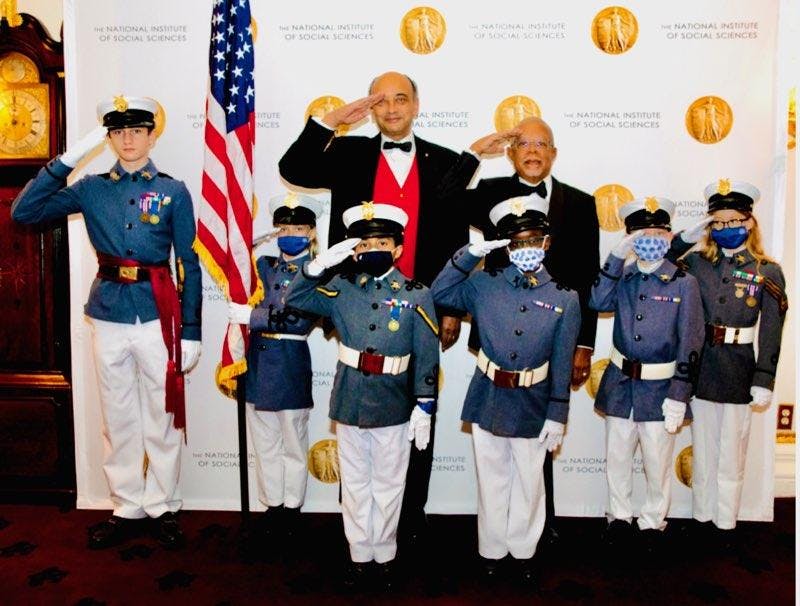Knickerbocker Greys Face Prospect of Eviction From Their Home of 121 Years at Seventh Regiment Armory on Park Avenue
A New York housing court judge appears sympathetic to arguments by the Park Avenue Conservancy that the venerable youth cadet corps has no legal claim to the space.

A New York housing court judge appears sympathetic to legal efforts to evict a youth cadet corps, the Knickerbocker Greys, from its home of more than 120 years at the Seventh Regiment Armory following arguments Wednesday.
A lawyer for the Park Avenue Conservancy, a performing arts non-profit which occupies the armory and is seeking to evict the Greys, compared the venerable youth organization to an unwanted roommate in remarks to the Sun following the hearing.
The arts organization could have “just locked them out and thrown their stuff out on the street,” the lawyer, Michael Pensabene, tells the Sun.
The conservancy has previously argued that there is insufficient space to accommodate the cadet corps’ 800-square-foot office in the 200,000-square-foot facility.
“If you have a roommate in your apartment, and you have a girlfriend and you now want to live with your girlfriend,” Mr. Pensabene tells the Sun to analogize the conservancy’s position, “do you let your roommate stay in the apartment because he’s been in the apartment for five years and he’s your friend?”
The hearing on Thursday in Manhattan centered on conflicting claims about a series of lease and licensing agreements signed by the parties in the past 17 years since the conservancy took over most of the armory from New York’s Military and Naval Affairs department.
Mr. Pensabene argued before Judge Jeanine Johnson that the Greys had used the space in the armory only at the Conservancy’s whim, without any legal privilege to occupy their basement office.
Since then, Mr. Pensabene said, the Greys have occupied portions of the basement of the armory “pursuant to a series of license agreements.”
Mr. Pensabene contends that because the “master lease” between the state and the conservancy does not make provision for the Greys, the “defenses raised” by the Greys should be dismissed as “noise.” The Greys by contrast disagree with this interpretation and believe the lease provides them rights to use the armory space.
Judge Johnson appeared to find the conservancy’s argument persuasive during the hearing, but also asked the conservancy what alternative space they could find within the 200,000-square-foot armory for the Greys.
The Greys’ attorney, David Hershey-Webb, observed that the conservancy’s actions are contrary to the purpose for which New York State gave them the lease over the historic armory.
The Greys also contend that efforts to evict the group conflict with promises that the Greys contend were made by the conservancy to city officials and politicians when the armory space was leased to the arts organization.
At the time, according to the Grey’s board president, Adrienne Rogatnick, the conservancy had been supportive of allowing the Knickerbocker Greys to retain their long-used space.
Yet as the conservancy has continued transforming the cavernous armory facilities into avant-garde art galleries and a performance venue, Ms. Rogatnick said, the management seems to have grown weary of “young children in uniforms” who could be harming the ambiance of the space.
Judge Johnson did not indicate when her ruling would be expected.
The Greys, founded in 1881, bill themselves as the oldest after-school activity in the United States, using the Seventh Regiment Armory for drills since 1902.
The Greys count over 5,000 among their current and past ranks, including Vice President Rockefeller and numerous past members of the Seventh Regiment, some of whom died serving in World War I and World War II.
The armory lobby prominently displays plaques dedicated to members of the Greys who died while serving in America’s wars.
If the eviction is successful, the Greys say it is unclear how the corps, currently consisting of around 30 members, will be able to continue attracting new cadets, calling the group’s future into doubt.
During the eviction dispute, the Greys have received backing from the local community board and politicians including Congresswoman Maloney, who sent a letter in appeal to Governor Hochul in support of the group; state Senator Liz Kreuger; and the Manhattan borough president, Mark Levine.
When asked about the outpouring of support garnered by the Greys, Mr. Pensabene said, “there is a lot of public support the other way. You know how many people support the armory? You know how many people go to our shows? If you put them in a room, the ones who support are going to far outnumber those against the armory.”
______
This article has been updated with additional information from representatives of the Knickerbocker Greys.

